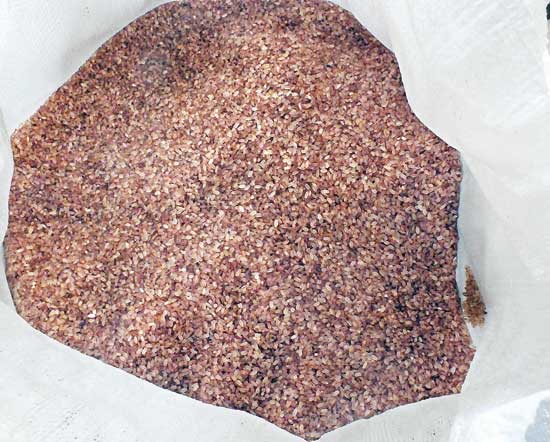Red rice and red-coloured rice
View(s):Many of our rice farmers are poor and the price they receive for paddy harvest is too low. On the part of the consumers – about 22 million people in Sri Lanka – market price of rice, their staple food, is too high. Accordingly, the price should be “higher” for the farmers, but it should be “lower” for the consumers! How do we solve this puzzle?
Today, I am going to deal with this puzzle.
Sri Lankan speciality
Nowadays, there is a shortage of ‘red raw rice’ in the market. The issue seems to be worse than anticipated as many
Sri Lankans wanted to cook “milk rice” from red raw rice for the New Year’s day and the Thai Pongal day. Unlike in our neighbouring countries, many red rice varieties are quite common in Sri Lanka.

Red Nadu rice.
One day I took a few of my South Asian friends who had visited Colombo for a meeting, for their last-minute shopping before departure. After seeing ‘red rice’ at the supermarket, one of them was stunned and said: “I have never seen ‘red rice’ throughout my life.”
In fact, I too was surprised to see that. Later I came to know that red rice varieties are not so common in many of our neighbouring countries unlike in Sri Lanka. And I too never had red rice served in any of the Asian countries when I visited them.
Among the red rice varieties, red raw rice is one of the most demanded and the cheapest rice varieties in Sri Lanka. While rice is Sri Lanka’s staple food, many Sri Lankans have the habit of eating red raw rice which is also believed to have higher nutritional value. For the same reason, perhaps, “red raw rice restaurants” are also quite common in Sri Lanka.
Red is washed away
A few years ago, a kilogramme of red raw rice was going at Rs. 75 in the market. At the same time, one of the agro-business companies was producing its own red raw rice variety of higher quality and supplying to the consumers at a higher price. Suddenly, the government imposed a price control on common rice varieties, including red raw rice.
I could not find anymore the red raw rice of higher quality at that business company’s sales outlet in Colombo. One day I asked the manager about the red raw rice which was no more available there. And I came to know that the company has stopped its production because it was unable to produce it without a loss at the controlled price. Therefore, the company had abandoned the production of red raw rice.
Red rice that was available in the market at a controlled price had also deteriorated further in quality. Many complained about the low quality of red rice. Some had observed that red rice had been coloured in red; the colour dissolved in water when rice was washed for cooking.
That’s how the price controls in the past have wiped out “good quality products” from the market and brought about “inferior goods” to the market. Price controls hurt the poor more than the rich. While the rich, anyway, have access to “more superior varieties” of rice which do not come under the price controls, it is the poor who should buy the low-quality rice at a controlled price, if it is available at all.
Protecting farmers
Usually, government’s subsidies, administered prices and import protection are all maintained for the purpose of poverty alleviation and food security. The agriculture sector does not guarantee adequate income for farmer families so that government support helps them at least to survive, not thrive for sure.
 Without external support, it is quite possible that food production may fall because it is not a rewarding commercial activity. Therefore, in Sri Lanka paddy cultivation has been receiving extensive government support throughout the history.
Without external support, it is quite possible that food production may fall because it is not a rewarding commercial activity. Therefore, in Sri Lanka paddy cultivation has been receiving extensive government support throughout the history.
The paddy sector is not taxed unlike other business activities. As essential inputs, water is at free of charge to the farmers and fertiliser supply is heavily subsidised. The sector is protected from imports at the expense of consumers. Government ensures guaranteed price, while specific government institutions and bureaucracy are maintained at taxpayers’ money to serve the sector.
With all that paddy farmers still remain poor and vulnerable to sudden shocks such as droughts and floods.
Too small to survive
The most fundamental cause of all problems is the “smallness” of Sri Lanka’s farm plots that are too small to derive a sufficient income for the farmers. As per “2022/2023 Maha season” data from the Department of Agrarian Development, there are over 1 million paddy farmers in Sri Lanka – about 12 per cent of the country’s total labour force.
It is not only that “there are too many paddy farmers in Sri Lanka by international standards”, but also their average farm size, which is less than 2 acres, is too small. According to Global Agricultural Information Network, 45 per cent of farmers hold less than 1 acre of paddy fields; less than 5 per cent of farmers hold more than 5 acres.
Under this small-scale land-holding condition, obviously the farmers cannot survive without external support; but even with that support they would not thrive. Accordingly, they should be supported by the government, but at the expense of consumers and taxpayers.
The country’s 22 million consumers must pay a higher price for the survival of 1 million paddy farmers, while the taxpayers must also pay for maintaining the government agencies and their employment. It is a good question that “unless otherwise, what is the choice available to us?”
Import liberalisation
What would be the outcome, if the government decides to keep rice imports liberalised without any licensing scheme? Rice will be imported by private parties so that the price will go down for the benefit of the consumers. As per the recent news reports, rice from India would cost about Rs. 135 rupees a kg. The government too would benefit from tariff revenue and save taxpayers’ money for something else.
However, not only farmers but also many others would think that “this is insane” because it would destroy local paddy production as well as the country’s food security. It is true. However, let me elaborate the underlying economic principles. Why would import liberalisation destroy paddy production?
It is because the majority of our paddy farmers are operating on survival mode; by international standards, we have too many farmers producing too little output on too small farm plots. About 25 per cent of our labour force is in the agriculture sector, whereas in the countries with a globally competitive agriculture sectors farmers comprise less than 5 per cent of the labour force.
Excess labour
The problem is that with inadequate industrial and service sector development, Sri Lanka has failed to allow excess labour to flow into urban-based non-agriculture sectors. As long as we keep delaying this process, obviously we must meddle with the question how to support our farmers and pay for taking care of those whose agriculture income is too low to survive. There is no overnight solution to the problem.
With a reduced workforce in the agriculture sector, there is no reason why
Sri Lankan rice cultivation or agriculture sector cannot be competitive globally. In fact, Sri Lanka will also focus more on our own exotic rice varieties such as “red rice” which are not common in other countries. And the farmers will thrive in agriculture with higher farmer incomes and greater capacity for agriculture modernisation on their own and even with better bargaining power in the market.
What about food security? Well, food security is all about availability, affordability and quality of food. And we know that we have not maintained any of these things which is why our food security is at a risk; it is much riskier than that of many non-agricultural economies in the world.
All the above gives us some policy choices. We can maintain the current status-quo and continue with protection and subsidies. Or we can start executing broad-based reforms for transformation.
(The writer is Emeritus Professor of Economics at the University of Colombo and can be reached at sirimal@econ.cmb.ac.lk and follow on Twitter @SirimalAshoka).
Hitad.lk has you covered with quality used or brand new cars for sale that are budget friendly yet reliable! Now is the time to sell your old ride for something more attractive to today's modern automotive market demands. Browse through our selection of affordable options now on Hitad.lk before deciding on what will work best for you!


